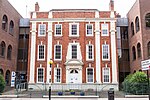Friargate Coventry

Friargate is a new business district in Coventry, currently under construction. Covering 37 acres (15 ha) surrounding Coventry railway station, once complete Friargate will be made up of 25 new buildings, including 14 Grade A office buildings, two hotels and new homes.The project is scheduled to take 15 years to complete and is thought to be providing 15,000 new jobs at a cost of £100 million. It has been described by the Coventry Telegraph as one of the twelve new developments that will change Coventry forever.The former leader of Coventry City Council, Cllr Ann Lucas, has stated that developments such as Friargate will help the city achieve its aim of being a top 10 UK city.On 10 March 2016 Station Square, the new public thoroughfare created as part of the development, was opened by Cllr Lucas. The space features more than 200 trees, stone benches and seats and was heralded as proof that Friargate is already changing the area.
Excerpt from the Wikipedia article Friargate Coventry (License: CC BY-SA 3.0, Authors, Images).Friargate Coventry
Manor Road, Coventry Cheylesmore
Geographical coordinates (GPS) Address Nearby Places Show on map
Geographical coordinates (GPS)
| Latitude | Longitude |
|---|---|
| N 52.402222222222 ° | E -1.5133333333333 ° |
Address
One Friargate
Manor Road
CV1 2GN Coventry, Cheylesmore
England, United Kingdom
Open on Google Maps









